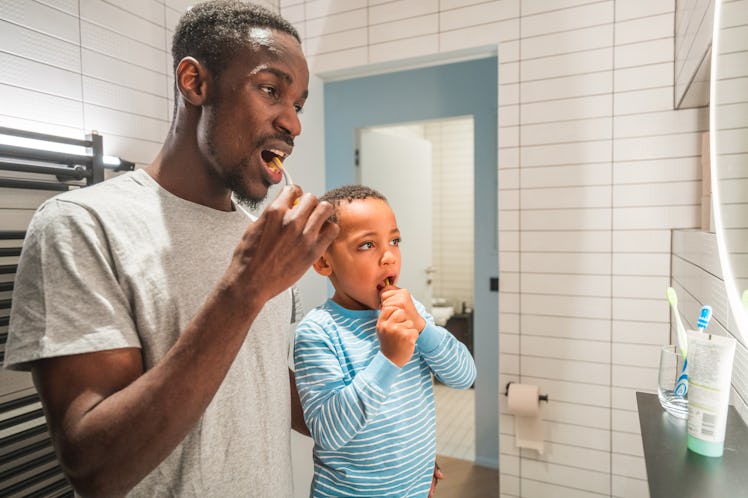Kids Suck At Brushing Their Teeth. One Tiny Change Makes Them Way Better
A new study finds there’s one very easy way to make your kid’s oral hygiene way, way better.

“Go brush your teeth.”
“I did!”
“You did? Lemme see.”
If you’re a parent, you know what happens next. Visual — or scent-based — proof usually follows that your child absolutely did not brush their teeth. Or if they did, they didn’t do it very thoroughly. It’s one of the most mundane, but important, hygiene battles that parents all fight. Establishing good dental hygiene is no small task when it comes to stubborn kids, but it’s also essential for their long-term health. What if there were a way to sidestep (most of) the battle altogether?
Luckily, researchers have found one small tweak desperate parents and stinky-mouthed children can make to their toothbrushing routine that will get teeth cleaner and help your kids become more effective toothbrushers, and honestly, it’s kind of a no-brainer. An electric toothbrush.
Yep. It’s just that simple.
Here’s the deal: Poor dental hygiene isn’t just a grown-up problem. In fact, it’s a huge problem for kids. Seventy-four percent of kids aged 9 months to 6 years have cavities and gingivitis. Fifty percent of 5-year-olds have at least one cavity.
Good dental hygiene isn’t just about preventing cavities and sparing kids the discomfort of getting them filled. Gum disease and periodontal disease have been linked to a host of chronic conditions in adults — cardiovascular disease, mental health concerns, diabetes, and some autoimmune diseases. Plus, cavity fillings can be expensive to maintain, making prevention — by way of sparkling pearly whites — a very important investment into your future teeth.
Luckily, a new study that examined the toothbrushing habits of 3- to 10-year-olds, found that electric toothbrushes significantly improved plaque reduction across the board. A research team from the Hebrew University-Hadassah Faculty of Dental Medicine followed two groups of children for four weeks. One group used a standard Oral B oscillating rotating (OR) toothbrush, while the other used a Paro Junior manual toothbrush. Seven to 10-year-olds brushed themselves while parents brushed for kids 6 and under.
The team found that the group using the electric toothbrush had surprisingly better results than those brushing manually, though both groups did see a reduction in plaque and gum inflammation.
Older children using an electric toothbrush had 94% greater whole-mouth plaque reduction and 108% back-of-the-mouth plaque reduction at week four than older children using a manual toothbrush. Kids from 3 to 6 years old had 55% greater whole-mouth and 34% back-of-the-mouth plaque reduction at week four compared to kids the same age using a manual toothbrush. Gum inflammation, or gingivitis, was similarly improved with an electric toothbrush compared to brushing manually.
None of this should be so surprising: for any of us adults who have been accused of brushing too hard by our dentist, that slanderous accusation is usually followed by a recommendation — get an electric toothbrush, and, of course, floss. But the study confirms that making the switch from manual to electric isn’t just good for mom and dad. It’s good for kids, too.
And maybe — just maybe — it will make tooth brushing more fun.
“Young children love to use electric toothbrushes, yet most studies have only focused on whether electric or manual toothbrushes are better for reducing the dental plaque that causes cavities and gingivitis in adults,” study co-author Prof. Avi Zini, DMD, dean of Hebrew University-Hadassah Faculty of Dental Medicine explained in a statement. “As long as children use their electric toothbrushes according to manufacturer’s instructions, the results should be very beneficial for their oral health.”
Still, that’s a fairly big caveat. We all know we struggle to get our kids to use their manual toothbrushes correctly. But there are some ways to make oral hygiene less of a chore, even if it’s still a battle on your part. If you join your kid while they’re brushing their teeth, you can make sure they’re doing it right. You can also help them pick out the electric toothbrush and toothpaste they want to use — even if it’s some berry-blast flavored you find disgusting. Giving them a choice may make them less hesitant to do what they need to do.
This article was originally published on